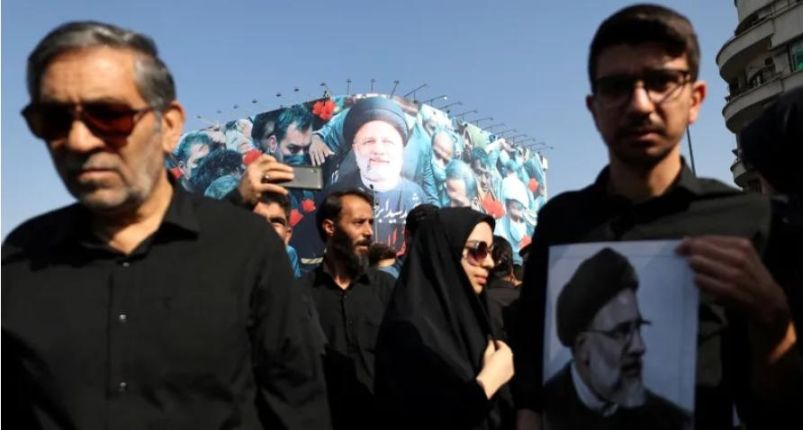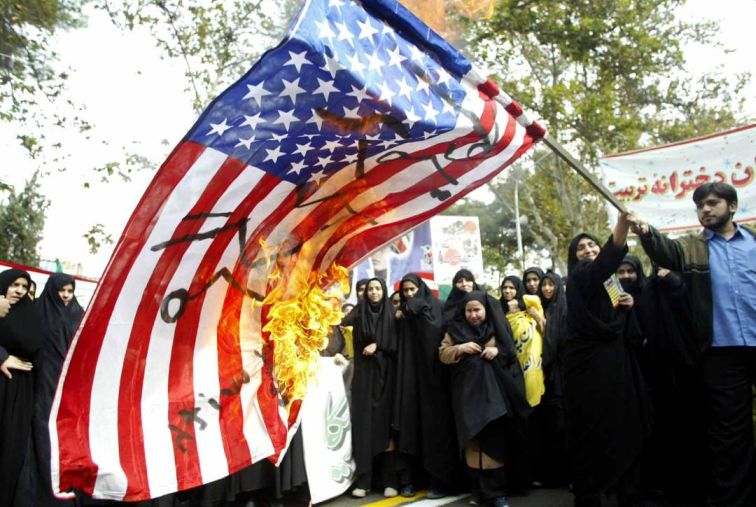By Eric Vandenbroeck and co-workers
Whoever Succeeds Him Won’t Change
Course
The sudden death of
Iranian President Ebrahim Raisi in helicopter crash
on May 19 marked a momentous day for the Islamic Republic. His presidency
ushered in a new era for his country, characterized by increased militarization
abroad and growing tumult at home. Not since the 1979 revolution had Iran’s political
system faced such a fast-paced transformation. Externally, the country
surprised the world with its military capabilities and its willingness to
deploy them. Internally, Iran grappled with rising secularization, putting
society at odds with the government. These shifts meant that the Iran that
exists today is very different from the one that existed when Raisi came to power just three years ago.
Without Raisi, it may seem like Iran is headed for a
period of great turbulence. Before his ascent, Iran’s supreme leader, Ali
Khamenei, spent 30 years in near-constant conflict with Iran’s presidents,
sparring over what path the country should take at home and abroad. But Raisi adopted Khamenei’s preferred, Middle East–first
approach to foreign policy, expanding Iran’s regional influence and improving
relations with its neighbors, including its rival, Saudi Arabia. He made sure
that Iran’s presidential bureaucracy synced up with the supreme leader’s. He
deepened ties with China and Russia and vastly expanded his country’s nuclear
program. Raisi was so loyal to Khamenei that he was
widely viewed as his heir apparent.
Yet it is unlikely
that Raisi’s death will cause much tumult in Tehran.
In fact, it is unlikely to prompt much change at all. Despite popular
discontent and an expanding crisis of legitimacy, Iran’s powerful ruling class
remains steadfast in its commitment to Raisi and
Khamenei’s strategy. Iranian elites will ensure that the presidency stays in
the hands of a loyal establishment conservative. They will keep the country’s
policies steady. There will still be palace intrigue, as the country gears up
for a snap election and ambitious politicians launch their candidacies to
succeed Raisi. But Iran’s next president will almost
certainly be just like its last one, and nationwide grief at Raisi’s death will ensure that the winning candidate has a
smooth transition.
Thick And Thin
Raisi’s rise to power began in the 1980s. Then a prosecutor
and judge, he made a name for himself by having thousands of leftist prisoners
executed. A student of Khamenei’s jurisprudence classes, he eventually advanced
to become Iran’s attorney general, taking up the post in 2014. He next presided
over a multibillion-dollar religious foundation in the holy city of Mashhad
before being tapped in 2019 to head the judiciary.
Raisi
ran to become Iran’s president in 2017, but lost to the incumbent, Hassan
Rouhani. His defeat in that contest also turned into a defeat for Khamenei.
Although the supreme leader controls key institutions, including the military
forces, and sets Tehran’s overall policies, Iranian presidents control a vast
bureaucracy and budget that give them many levers to shape, challenge, delay,
or sabotage Khamenei’s programs. Iran’s presidents also derive some legitimacy
from being elected directly, unlike the supreme leader. Rouhani, for example,
used his power to chart a course far more moderate than that preferred by
Khamenei, including pursuing a nuclear deal with the United
States during his first term.
As a result, in the
leadup to the 2021 election, Khamenei maneuvered to ensure that Raisi would win. Seizing on the collapse of the nuclear
agreement, which was precipitated by the Trump administration’s withdrawal from
the deal in 2018, the supreme leader had Iran’s Guardian Council disqualify all
other serious contenders. The result was less a contest than a carefully
managed coronation. With Khamenei’s blessing, Raisi
won office with 62 percent of the vote—and the lowest voter turnout in the
Islamic Republic’s history.
Raisi
took over the executive branch when Iran was under economic siege.
The Trump administration had imposed crippling sanctions in 2019. U.S.
President Joe Biden’s administration tried to leverage those sanctions to reach
what Biden called a “longer and better” deal. But Raisi,
unlike his predecessors, showed little interest in talks. Instead, he shifted
Iran’s foreign policy from a westward-looking approach aimed at removing U.S.
sanctions—what Khamenei derisively termed a “begging” foreign policy—to a more
Middle Eastern and Asian- focused strategy aimed at neutralizing them. This
policy aligned with the vision that Iran’s supreme leader had been advocating
for decades.
The Iranian Foreign
Ministry, for example, has traditionally been at odds with the supreme leader’s
Islamic Revolutionary Guard Corps, which prioritizes supporting Iran’s
extensive network of nonstate proxies, such as Hezbollah in
Lebanon and the Houthis in Yemen. But Raisi tapped
Hossein Amir-Abdollahian, a diplomat close to senior corps officials, to lead
the ministry. (Amir-Abdollahian died in the helicopter crash with Raisi.) Once marginalized for being too tightly in sync
with the IRGC, Amir-Abdollahian set about making sure that his ministry acted
in tandem with the corps. He promoted other diplomats with ties to the IRGC and
provided more support for Iran’s allied forces throughout the region.
The result of this
realignment was an assertive foreign policy. The IRGC, for example, was once so
constrained by the Foreign Ministry that the head of the corps’ aerospace
division bitterly complained about efforts by Rouhani’s officials to block
missile tests. But when Raisi came to power, the IRGC
began testing at will. It also began launching more outright missile attacks,
such as the barrage unleashed on Israel in April after Israel bombed Iran’s
embassy in Damascus. Under previous presidents, the corps might not responded
with such force.

For Better And For Worse
The Raisi administration had some unambiguous accomplishments.
It managed to reestablish relations with Arabia, for instance, and it
forged new economic ties with China. According to the Financial Times,
the Islamic Republic succeeded in increasing its oil exports from roughly 400,000
barrels per day to 1.5 million—despite crushing U.S. sanctions.
But many of Raisi’s supposed wins have little to do with his decisions.
The new ties to China and Russia, for example, are the product of growing
tensions between Washington and Beijing and Russia’s invasion of
Ukraine—not developments in Tehran. And many of the Iranian president’s other
policies have failed. His attempt to create an inward-looking self-sufficient
economic policy, an aim shared by Khamenei, fell flat. Raisi
spent a significant portion of his presidency traveling throughout the country,
reopening bankrupt factories, building roads, and initiating various
infrastructure projects. In fact, he was returning from the opening ceremony
for a dam when he died. But despite his claims that the Islamic Republic could
thrive under Western sanctions, the country continued to suffer from major
economic problems. The country’s inflation rate, for example, has remained
above 40 percent.
Raisi
also faced social unrest. Even government-sponsored reports acknowledge that
Iran is rapidly becoming more secular. The vast majority of the population
supports separating religion and politics, and many Iranian women walk around
unveiled, particularly in major urban centers. The government’s decision to
arrest and jail people for doing so prompted major protests in 2022. Even some
traditionally conservative women are now bucking the regime’s dress code, if
only to avoid being associated by other Iranians with the political system and
its failures (especially its draconian human rights record).
Raisi
continued to enforce the country’s dress requirements, and he responded to the
mass protests with more mass executions. But despite the violence, the Islamic
Republic is reluctantly acknowledging its population’s secular shift. During
the 2021 presidential campaign, for example, women who did not adhere to
traditional veiling practices appeared in pro-Raisi
advertisements. And today, state-controlled media show people from all walks of
life paying respect to the late president. In a television interview from a
vigil in Tehran, one mournful, partially unveiled woman told Iran’s state
broadcaster that although her “appearance may not be what it should be,” nobody
had forced her to attend. “I came here myself with
all my being.”

Meet The New Boss
Raisi’s vice president, Mohammad Mokhber,
is now the country’s acting president. Like Raisi, he
is a Khamenei loyalist; Mokhber joined the
administration after overseeing business conglomerates controlled by the
supreme leader. But his tenure may not last long. Under Iran’s constitution, a
new election must be held within 50 days, and multiple candidates will vie for
the presidency.
The election could
reopen Iran’s old factional wounds as candidates from different camps enter the
race, only to be disqualified. Yet such an outcome is unlikely. Instead, the
tragic circumstances leading to the election will probably strengthen conservatives’
hands, mending or covering over such fault lines. Prominent moderates are
already mourning Raisi: Rouhani, for example, has
offered condolences, as has another moderate former president, Mohammad
Khatami. They have done so even though they have been marginalized from
politics by Khamenei.
The national mourning
could shape more than just this election: it could mold the presidency in the
image of Raisi for years to come. The country’s
clerical elite will memorialize the late president as the kind of loyal Iranian
public servant that all future presidents should aspire to be. Their ideal
successor will, accordingly, be a conservative associate of Raisi—someone
capable of quickly assuming office and ensuring that “there will be no
disturbances in the country’s affairs,” as Khamenei promised in his first
statement about the helicopter crash in which Raisi
perished.
Iranian society
itself might also embrace Khamenei’s policies. Iran’s elite may struggle to win
over the public through religious messaging, but it does gain support by
promoting nationalistic narratives that portray Iran as a great power under
siege from the West. After the United States assassinated the senior IRGC
commander Qasem Soleimani in 2020, for example, the country experienced a
powerful rally-round-the flag effect, with hundreds of thousands of Iranians
coming out to pay tribute. Although Raisi’s death was
an accident, it could have a similar effect. Because he was killed while
serving the nation, the government declared him a martyr. In a country facing
external challenges, his death while on duty will resonate with many citizens,
particularly the regime’s base. The Islamic Republic is a resourceful system
that benefits from having loyal elites, living and dead.
None of this means
that Raisi’s death will deal no damage to Iran. The
president was viewed as the top contender to be Iran’s next supreme leader, and
Khamenei, age 85, will now have to scramble to find someone else. There is no
clear answer to who that might be. Some analysts have speculated that
Khamenei’s son, Mojtaba Khamenei, and the current head of the judiciary,
Gholam-Hossein Mohseni Ejei, are the leading candidates. But ultimately, the
individual chosen may not matter as much as the kingmaker. The conservative
institutions that choose the next supreme leader, and that backed Raisi as president and as a potential successor to
Khamenei, will have great power over whoever comes next.
That means that
Iran’s long-term trajectory is unlikely to change. Whoever becomes president
will be a loyal insider. He will be as politically similar to Raisi as one can be, Raisi’s
successor could even explicitly claim the latest president’s mantle. After all,
in the official narrative of the Islamic Republic, Raisi
will be remembered for putting Iran on the right path after a series of
presidents who challenged the supreme leader’s vision. He will be memorialized
for positioning Iran as a nuclear threshold state and establishing it as a
rising power—and for doing so not despite external pressure, but because of it.
For updates click hompage here